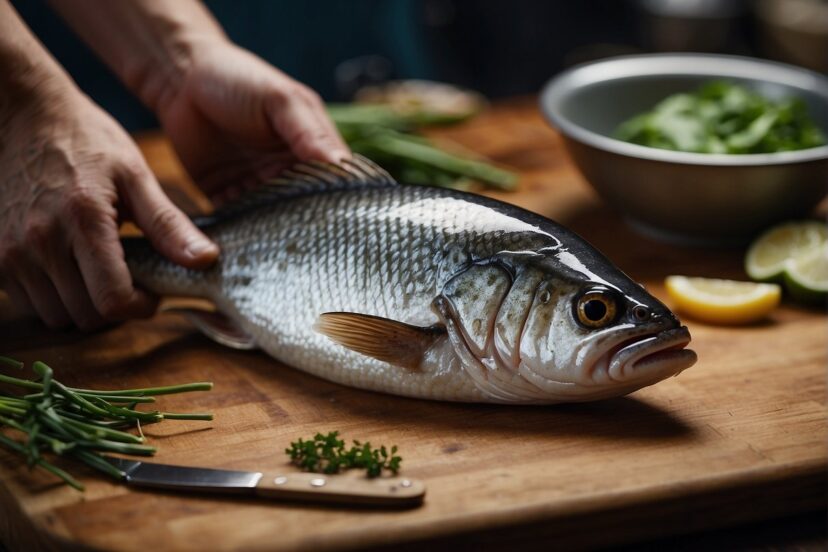How to Clean a Fish: A Step-by-Step Guide for Beginners
*We may earn a commission for purchases made using our links. Please see our disclosure to learn more.
How to Clean a Fish: A Step-by-Step Guide for Beginners
How to clean a fish is an essential skill for anglers and cooks who appreciate the freshness and flavor of a well-prepared catch. I approach this task with respect for the fish and attention to detail, ensuring that I preserve the quality of the meat. The process begins with removing the scales, followed by gutting and, if necessary, filleting. Every step must be carried out with care to avoid damaging the delicate flesh.
My method involves a sharp knife and a straightforward technique to ensure the fish is cleaned properly. It’s a skill that I’ve honed over time, which can be mastered by anyone with patience and practice. Handling fresh fish requires a certain finesse, and knowing how to clean it effectively is a testament to a cook’s prowess. By keeping the workspace tidy and the tools clean, the process not only maintains hygiene but also honors the culinary tradition of preparing seafood.
Understanding how to clean fish is fundamental to making the most of the catch and achieving the best possible flavor in cooked dishes. It involves a series of steps that might at first seem intimidating, but with a bit of knowledge and the right tools, the task becomes a manageable and rewarding part of the cooking experience. The freshness of the fish is paramount, and by cleaning it correctly, that freshness is captured and translated into delicious seafood meals.
Preparing Your Tools and Workspace

When it comes to cleaning a fish, having a well-organized space and the correct tools within reach is crucial. I’ll guide you through selecting the right knives and setting up an efficient cleaning station in your kitchen.
How to Clean a Fish: Selecting the Right Knives
Essential Knives:
- Fillet Knife: A sharp fillet knife is necessary for precise cuts. Ensure the blade is flexible to maneuver easily.
- Kitchen Shears: These are optional but handy for cutting off fins or making initial incisions.
Maintenance:
- Always sharpen your knives prior to use to ensure clean cuts.
- Clean and dry your knives immediately after use to maintain their condition.
Setting Up Your Cleaning Station
Essential Items:
| Area | Equipment |
| Work Surface | Cutting board (Non-porous and stable) |
| Cleaning Area | Sink or bucket of water (for washing the fish) |
Station Preparation Steps:
- Workspace: Cover the area around your cutting board with newspaper to collect scales and debris for easy cleanup.
- Hygiene: I recommend wearing gloves to keep my hands clean and protect from cuts.
- Accessibility: Position your tools and a container for the clean fish within arm’s reach to maintain a smooth workflow.
By following these steps, my workspace stays organized, and I am equipped to handle the fish cleaning process efficiently.
How to Clean a Fish – Killing and Storing

In ensuring both humane treatment and the retention of freshness, the manner in which I kill and store my catch is pivotal.
Humane Methods to Kill the Fish
When I catch fish, I employ humane methods to kill them quickly and reduce suffering. Two widely accepted practices include:
- Sharp blow to the head: I use a weighted club to deliver a sharp blow to the top of the fish’s head. This action disrupts the brain function, causing immediate unconsciousness and death.
- Iki Jime or brain spiking: With a sharp tool, I swiftly pierce the fish’s brain cavity, which results in instant death. This traditional Japanese technique is precise and considered one of the most humane methods.
Storing Your Catch Properly
Upon killing the fish, storing it correctly guarantees maximum freshness. Here is how I do it:
- Bleeding the fish: I cut the gills or use a knife beneath the gill plate to allow the fish to bleed out. This step prevents blood from spoiling the flesh and improves the quality of the meat.
- Refrigeration: If I’m not planning to clean the fish immediately, I place it in a cooler on ice or store it in the refrigerator. This keeps it at a safe temperature to prevent bacterial growth.
- Freezing: If I’m storing the fish for more than a couple of days, I wrap it tightly to prevent freezer burn and store it in the freezer.
- Using a stringer: If I continue fishing, I can keep fish alive longer by using a stringer in the water, which helps maintain their freshness until I’m ready to proceed with cleaning and storing.
By following these steps, I ensure that the fish I catch remain fresh, from the moment of capture to the time they’re prepared for cooking or long-term storage.
How to Clean a Fish: Scaling and Gutting

Before starting the scaling and gutting process, I make sure to have the proper tools at hand, such as a descaling tool, kitchen shears, and a sharp knife. I focus on being thorough yet gentle to avoid damaging the flesh of the fish.
Removing Scales and Fins
- Scales: I begin by descaling the fish from tail to head using a spoon or a fish scaler, ensuring to remove the scales evenly. I take extra care around the fins because scales here can be tougher to remove. It’s important to rinse the fish under cold water to wash away loose scales.
- Fins: I then use a pair of kitchen shears to snip off the fins. Doing this makes the fish easier to handle and minimizes the risk of getting pricked by the fins when I’m gutting.
Gutting and Cleaning the Innards
To gut the fish, I start by making an incision along the belly from the anal opening up towards the head. I use the tip of my knife and keep my cuts shallow to avoid puncturing the intestines. Once open, I remove the entrails carefully, making sure no waste contaminates the flesh. I also check for the kidney along the backbone which can be scraped out with a spoon or knife. After removing the innards, I thoroughly rinse the abdominal cavity under cold running water.
Removing the Head and Tail
If the recipe requires, I will remove the head by cutting through the fish just behind the gills and pectoral fins. To remove the tail, I make a cut where the tail meets the body of the fish. Some recipes call for the head and tail to be left on, so this step depends on the final presentation desired.
How to Clean a Fish: Fillet the Fish
When filleting a fish, it is crucial to have a sharp knife to make clean cuts and to work with precision to avoid wasting any edible parts of the fish. Ensuring the fillets are boneless requires attention to detail during the cutting and deboning process.
Cutting and Removing the Fillets
I start by laying the fish on a stable surface with the dorsal side nearest to me. With my sharp fillet knife, I make an incision behind the gills and pectoral fin, cutting down to the spine without going through it. I then turn the blade towards the tail, sliding it along the spine with steady pressure to separate the fillet from the bones.
- Step 1: Incision behind gills and pectoral fin
- Step 2: Slice following the spine towards the tail
Next, I flip the fish over and repeat the process on the other side. Each fillet should look symmetrical if done correctly. I lift the separated fillets and inspect them to ensure they are clean and intact.
- Step 3: Flip and repeat
- Step 4: Inspect fillets
How to Clean a Fish: Deboning the Fillets
With the fillets now removed, I focus on deboning. I feel along the flesh for any remaining pin bones and use kitchen tweezers or my fingers to carefully remove them. It’s important for me to remove all the bones for a completely boneless experience.
- Step 1: Feel for pin bones
- Step 2: Remove bones
If I desire to skin the fillet, I place it skin-side down and actively insert the knife between the skin and flesh. Starting from the tail end, I hold the skin while sliding the knife with a sawing motion to separate the skin from the flesh.
- Step 3: Skin the fillet if necessary
Finally, I rinse the fillets under cold water to clean any remaining scales, bones, or debris. After patting them dry with a paper towel, the fillets are ready for cooking.
- Step 4: Rinse fillets
- Step 5: Pat dry and prepare for cooking
How to Clean a Fish: Post-Cleaning Process

After I’ve done the cleaning, it’s crucial to ensure the fish is prepared for storage or cooking. This involves a thorough rinse and proper drying or storage if not used immediately.
Rinsing and Drying the Fish
After cleaning the fish, I actively rinse the fillets with cold water to eliminate any residual scales, blood, or internal fluids that might impact the taste and quality. It’s important to handle the rinsing gently to preserve the flesh’s integrity. After rinsing, I lay the fish on a clean surface lined with paper towels. I carefully pat the fillets dry to eliminate excess moisture, which is crucial before moving on to cooking or storing the fish.
Storing the Cleaned Fish
If I’m not cooking the fish right away, proper storage is key to maintaining freshness. For short-term storage, I wrap the patted-dry fish in plastic wrap or aluminum foil and store it in the coldest part of the refrigerator. Fresh fish should be consumed within one to two days for optimal flavor. For longer storage, I wrap the fish tightly in a layer of plastic and then place it in a sealed freezer bag, pressing out as much air as possible. Freezing the fish at 0°F or colder will preserve its quality for up to four months.
Frequently Asked Questions About How to Clean a Fish
In this section, I’ll cover some of the most common questions regarding the process of cleaning a fish, with step-by-step techniques and best practices.
1. What is the correct technique for gutting a fish?
To gut a fish, I start by making a shallow incision from the anus up to the base of the gills. It’s essential to cut lightly to avoid piercing the intestines. Then I remove the entrails, taking care not to rupture them, as it can taint the flesh.
2. Can you explain the steps for filleting a fish?
When filleting a fish, I begin by laying the fish on its side and cutting behind the gills and pectoral fin down to the backbone. I then turn the knife parallel to the spine, slicing the fillet away by following the backbone to the tail, flipping, and repeating on the other side.
3. What process should be followed for cleaning a fish before cooking it?
Before cooking, I start by removing scales with a scaler or knife, then gutting the fish. Subsequently, I rinse the cavity and external body thoroughly in cold water to ensure that I remove all blood and residue.
4. What precautions should be taken when cleaning a fish with its head on?
When cleaning a fish with its head on, I’m extra cautious not to puncture the gallbladder, as its contents can impart a bitter taste. I also remove the gills and any remaining internal membranes, rinsing well afterward.
5. What are the best practices for cleaning freshly caught fish?
After catching a fish, I keep it fresh and clean it as soon as possible. I remove the scales, guts, and gills under cold running water. I ensure I wash and sanitize my hands and tools to prevent contamination and spoilage.




